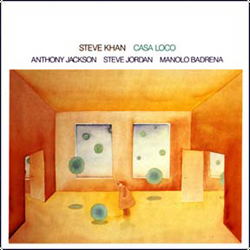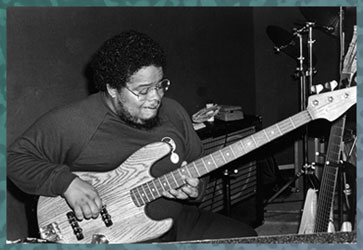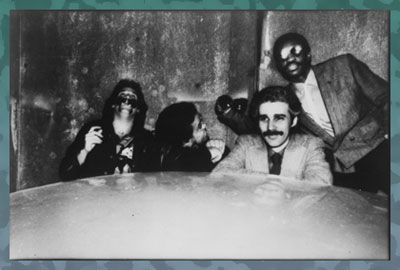When
Anthony Jackson,
Steve Jordan,
Manolo Badrena, and I formed
Eyewitness in 1981, part of the beauty of it all was that there was always going to be an element of not knowing exactly what we were doing, musically speaking. This was certainly part of the appeal for each one of us. When we entered the studio to record "
EYEWITNESS," way before many might have considered us as ready, we began our own little
tradition by recording one piece that was a completely improvised composition in the studio.

"Auxiliary Police" was born that way. For us it was more of a triumph of
mood and
attitude over melody and structure. It was certainly my hope that we would be able to compose tunes like that, on the spot, each time that we went into the studio to record. I was optimistic and envisioned us 6-7 albums into the future. As it turned out, we only recorded 3 albums together, and the middle album, "
MODERN TIMES" was live. Looking back over all these years, to have recorded 3 albums with all four of us intact seems like a grand accomplishment.
With 20-20 hindsight, it is a bit remarkable that we would even put these kinds of pieces out on a recording, but, in balance, there is just something so very different about the way that tunes like "Auxiliary Police" and "The Breakaway" come across. Now, all these years later, the great French Jazz journalist,
Frédèric Goaty, under the very clever
nom de plume of
Peter Cato, wrote a fantastic piece about
Eyewitness for
Muziq Magazine that celebrates the 3 albums by our group, and the perceived musical relationship to the great, great band, The Police. If people heard things that way, in the end, it was a most flattering honor for us, because it was not intentional on our part.
I have often thought that the test of any musical composition would be if musicians on instruments other than the guitar might ever consider performing or recording that same piece. If a tune does not stand-up to that basic form of inspection, then it is probably not much of a composition. That doesn't mean that it can't be considered as successful on some level, even if there's not much there. "
The Breakaway" from our 3rd album together, "
CASA LOCO," is just such a piece. I can't imagine that any saxophonist, trumpeter, or pianist would choose to perform this tune. That stated, at some point over the two days or recording, Steve Jordan had just set-up his hybrid drum kit that included some real drums and integrated amongst them were some parts of a Simmons Electronic Drum Kit. It was a pretty remarkable concept. When attempting to record something like this for the 1st time, it requires some trial and error. Once Steve and engineer
Doug Epstein had arrived at an acceptable balance, it was time for a test. At such a point in time, usually the engineer will say to everyone: "Why don't you all play something together to check your headphone balances, and to see just what we're getting in here in the control room." At that time, we were still recording to 24-trk. analog tape. Well, it was at that moment that Steve Jordan decided to launch into some kind of a wild beat, a wild groove that sounded like nothing any of us had ever heard before. The next thing I knew, Manolo had joined in with his own hybrid percussion set-up that included electronics from Syn-cussion. Finally, from the recesses of the harmonic imagination of Anthony Jackson came an equally wild electric bass concept. I joined in, and the resulting "jam" became the very short tune, "The Breakaway."
With this cast of characters and the musical perspectives conveyed, I often feel that the most descriptive adjective for a piece like this might be a word like: zany! The spontaneous brilliance of Manolo Badrena is a huge part of that. I wish I could tell you what he might have been saying into that live microphone that was a part of his set-up, but, I don't know. Sometimes, before Anthony's entrance, I think that I hear Manolo saying "Jackson" - but I wouldn't bet on my ears. Before we hit letter [
B], the bridge, I often think that I hear the word "payback"!!! All those wild sounds you hear darting in and out, are all created by Manolo. The thing that sounds like an electric xylophone? That's him too!!! Then, out of nowhere, there can be the sounds of Latin music from his timbal. The crashes are often Manolo too. If you think that I "asked" Manolo to play like that, or to perform like that, it would be the furthest thing from the truth. I remember that this recording did not get released in the USA until 1985, and Manolo used to tell me years that later that other musicians and producers would say to him: "C'mon man, give me some of that wild shit that you play on Steve Khan's albums." And Manolo would look at them like they were crazy and, if pushed too far, he would eventually say: "What do you think I am, some kind of trained monkey? I play like that on Steve's albums, because that's what I feel! No one asks me to
do anything!!!" In the end, that's what makes Manolo Badrena so special, mercurial, but at times, totally brilliant, and most unique.
Over the many years that have passed since 1983, I have been asked about the sound that I used on the "CASA LOCO" album in general. The fundamental guiding principle for me, after the Columbia years(1977-1979) was to go back to a more
pure and simple guitar sound. In essence, that was to be a Gibson ES-335 guitar played direct into an amp, and with a little reverb for treatment. Of course, as the music developed from 1981 forward, I had to be more flexible about that, and a Fender Stratocaster appeared on some tunes as well. As the music for this particular album evolved, it just seemed that, once again, certain sections were going to need a little something
extra, and so, on this album, that sound was produced with the help of the very primitive
Ibanez Chorus(CS9). This particular pedal was a bit noisy sounding, not ideal for a high-quality audio recording, but it was in stereo, and was played through two Roland JC-120s.

"The Breakaway" turned out to be one of the Strat tunes on this album. I have to assume, because of the year, that I was still using my 'real' Fender Strat, and for this tune, it sounds like I was using that
in-between sound that comes from combining the middle pick-up with the bridge pick-up. From 1990 to the present, the major sonic difference is that then I had graduated to, what became my true voice where effects are concerned, the
Ibanez Digital Chorus/Flanger(DCF-10), which I have written about extensively at the
EQUIPMENT page here.
Anthony and I, to my recollection, really had no conversations at all about what he was playing. Based upon what I heard him playing, somehow I gravitated to a
whole-tone-ish harmonic area. Our center seems to be 'G' but the first chordal sonority that I played has the guts (A-F-Eb) of F7, though if you spell it: A-F-D#, then it could appear to be G7(9#5). Virtually any and all of the dominant 7th chord sounds a whole-step apart, using b5's or #5's, are going to sound fine in this kind of context. The interesting thing to me, in total hindsight, is that in the very first statement of what I have labeled as the [
A] section, I was still fishing around for what felt the most musical to me, rhythmically speaking. It wasn't until we arrived at [
A3] that I really had a more fully realized way to play the chordal portion of that section. [
A2], which is the linear portion of the melodic material, comes right out of the G whole-tone scale [G, A, B, C#/Db, Eb, F], and very simple G7#5 arpeggios. Look at bars: 2, 4, 6, and 8. I like how in [
A2] on Pg. 3, the little melodic units get moved around a bit, and it makes for a nice contrast. After the first statement of [
A2], and [
A] returns, via an overdub, I orchestrated a little sonority, spelling down: Db-B-G, via the same Strat, but using the bridge pick-up only and dialing it in with my Ernie Ball volume pedal.
Again, I have no vivid recollection as to how Anthony and I arrived at our [
B] section, and the fact that it goes to an area between E7 and Bb7, the b5 substitutes for one another. But, it certainly is effective. Here, once again, I used my little Strat orchestration device by creating a clustered sound on the downbeat every 2 bars. The basic voicings that I was playing live are very, very simple. In bars 1-2 and 5-6, you have an E7(9) chord with a high F# on top, and spelling up. that voicing is: E-G#-D-F#. So, by playing an additional voicing, spelling up: D-F#-G#-C#, you create 3 separate 2nds where once none existed. In bars 3-4 and 7-8, where the principal guitar is just playing a Bb triad, spelling down: D-Bb-F-D-(Ab). When I add in a simple Bb7 voicing, spelling up: Bb-F-Ab-D, you get a 2nd interval with the Ab-Bb next to one another. However, if there is anything remotely melodic about this bridge, it is all coming from Anthony's brilliantly arpeggiated lines. I recall that he completely improvised them, but upon listening to the playback, he decided to perfect them, and make them more of a composed part. So what you now hear is the result of a refinement of what was once improvised. Either way, it points out how incredible Anthony's mind can be. For all I know, this might well have been one of the last tunes that Anthony ever recorded with his classic old Fender 4-string bass.
As I have already spoken at length about both Anthony Jackson and Manolo Badrena, I can't let this posting go up without saying something about Steve Jordan too. There are not all that many players on any instrument about whom I would find myself saying: "Steve Jordan, he could do anything that he wants to do, musically speaking!" But, having said that, I know, and all too well, that it's not up to me to say what kind of music he should be playing. That's totally up to him. When I hear Steve's playing on tunes like both "Snakes" and "Ramblin'" from David Sanborn's "
UPFRONT"(Elektra) album, 1992; or on "Slang" and "Harpoon" from the Brecker Brothers' "
OUT OF THE LOOP"(GRP) album, 1994, I am reminded of just what a super-special player Steve is in the world of instrumental music. His feel, his sound, his attitude are all so unique. Yes, I have enjoyed his trio playing with John Mayer immensely, and his recent productions for both Robert Cray and Boz Scaggs. And, around and in between all of this he still found time to occasionally tour with Sonny Rollins. I will never forget a conversation that I once had with another one of my all-time favorite drummers, Rick Marotta. We were sitting together somewhere, and after having spent some years touring with Linda Ronstadt and James Taylor, he said this to me: "Steve, I just don't want to spend the rest of my life always being
somebody else's drummer!!!"

That one phrase helped me to understand him, and any number of other great, great drummers, who all wanted something more than that. It's not my place, nor anyone else's to think that
we know what is best for another musician. In the end, I'm just happy and grateful that Steve and I stay in touch, and that the distances between contact have not dulled our friendship and love for one another in the least. He will always be one of my favorite players, and it was a thrill and a privilege to have made these three recordings together.
"The Breakaway," for us, as a group, helped to define what our 'potential' future could be, because it incorporates elements which are unique to each of us. And this spirit of cooperation between
Anthony Jackson;
Steve Jordan;
Manolo Badrena and me provided us with so much hope. Here we mix elements of R&B, Rock, Jazz, World music, Latin music, and probably other things that I can't think of right now. I'll never ever forget that the tune "Casa Loco" included one of the great,
great drum solos ever recorded. It was the first time that we had recorded in the studio with Anthony's 6-string contrabass guitar. So many innovative things happened during our years together, and "CASA LOCO," the album, is a real high-water mark for both hybrid drum and percussion set-ups, that integrate highly creative and inventive electronic sounds that rarely appeared again in the context of instrumental music with the beautiful natural sounds of drums and percussion. All three of these great players are innovators, and they were brilliant on these albums, and their performances are to be treasured!
So, just what kind of music is this?!?!?! Well, it's certainly NOT
Jazz!!! But, the spirit of improvisation, invention, interaction, conversation and energy are all there. Does music need a category or a genre label? To musicians, absolutely not - it's just music. But, to those who bring the music to the people, those genre labels or categories are essential. They are the marketing people. And, for better or worse, we, the musicians, need them. However, with the disappearance of the record store, the CD stores, where there had to be 'sections' so that the shopper/music fan could locate his or her favorite recordings, dividing the space into genres and categories made perfect sense. It also makes sense for those who program radio stations. Does someone's music have to fit into their format? Honestly, I have NO IDEA just what kind of music "The Breakaway" is! It certainly has a kind of punky attitude that is really different for non-singing music, and if given the opportunity, I wouldn't hesitate from trying such an experiment again, because the fun is in not knowing what is going to happen. It is like walking over a gorge without a safety net, and I think that, as a group, we all liked that sense of risk too!!! Thanks to everyone who enjoyed this ride with the four of us between 1981-1985, it was our pleasure to have you along!!!

